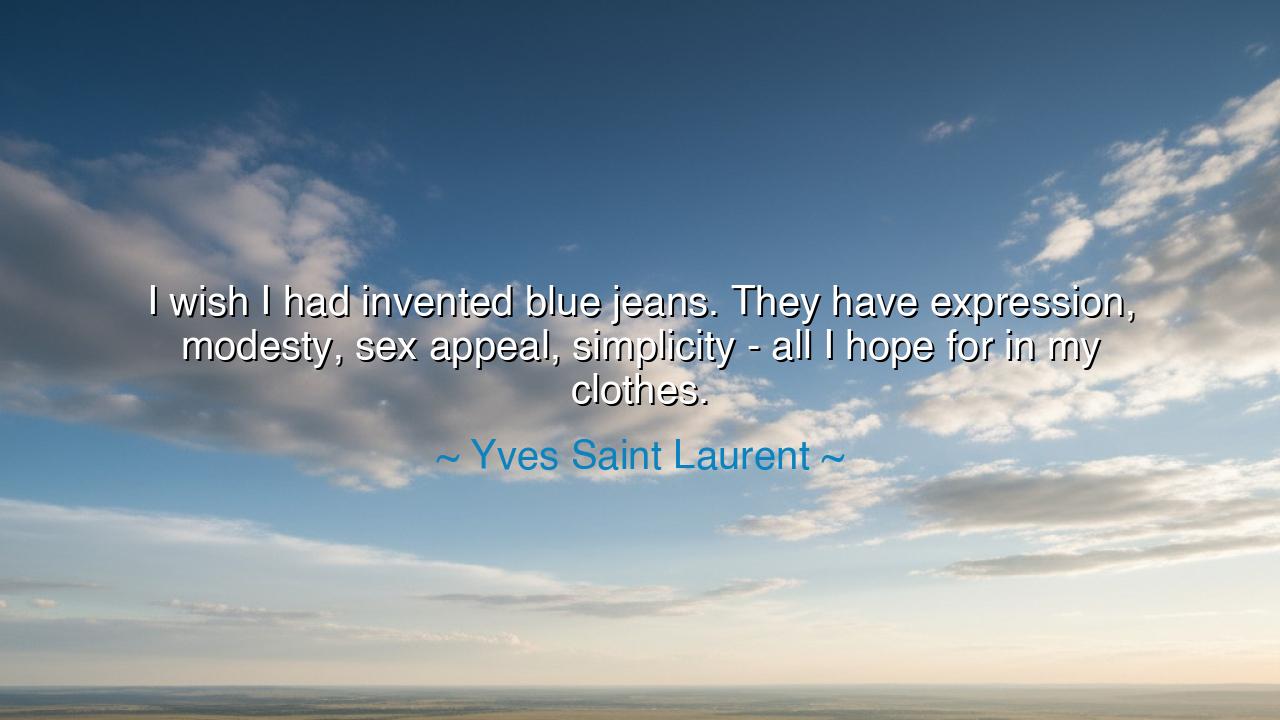
I wish I had invented blue jeans. They have expression, modesty
I wish I had invented blue jeans. They have expression, modesty, sex appeal, simplicity - all I hope for in my clothes.






In the eloquent and heartfelt words of Yves Saint Laurent, the great master of modern fashion, we find both reverence and revelation: “I wish I had invented blue jeans. They have expression, modesty, sex appeal, simplicity—all I hope for in my clothes.” In this simple confession, Saint Laurent unveils the eternal struggle of every artist — the desire to create something timeless, something that transcends the seasons of style and speaks directly to the soul of humanity. For blue jeans, humble in origin yet mighty in spirit, embody the rarest kind of beauty: that which unites the common and the extraordinary, the everyday and the eternal.
The origin of this quote lies in Saint Laurent’s lifelong pursuit of perfection through simplicity. Though he was known for haute couture — the world of elegance, luxury, and refined artistry — his heart was drawn to what was authentic, democratic, and universal. When he gazed upon the blue jean, he did not see mere denim. He saw the miracle of design that had escaped artifice — a garment that belonged to all people, rich and poor alike, young and old, men and women. To him, it was the purest manifestation of what clothing should be: honest, versatile, and alive with personality. It is the poet’s paradox that one of the most beautiful creations in fashion was not born from grandeur, but from necessity.
Indeed, the story of blue jeans begins not in salons or runways, but in the rugged hands of the working class. In the nineteenth century, Levi Strauss, a Bavarian immigrant in America, created sturdy denim trousers for miners and laborers during the California Gold Rush. What began as a garment of endurance — meant to withstand toil and sweat — transformed over time into a symbol of rebellion, freedom, and individuality. From the cowboys of the West to the youth of the 1960s, denim became a language of defiance and self-expression. In the faded indigo of each pair of jeans lay the story of the wearer — a testament to the lives they touched, the paths they walked, the dreams they dared to chase.
Saint Laurent, ever the philosopher of style, recognized that true design is not about extravagance, but about truth. He saw that blue jeans captured what every artist and thinker seeks: the ability to express the essence of life in a single form. In expression, they mirror the diversity of the human spirit — no two pairs ever the same, each bearing its own marks and memories. In modesty, they remind us that beauty does not require spectacle; it can live quietly, gracefully, without need for adornment. In sex appeal, they reveal how confidence and simplicity can be far more alluring than opulence. And in simplicity, they teach that the purest forms often endure the longest, for they are closest to the truth.
History itself is filled with examples of this wisdom — that simplicity holds the greatest power. The philosopher Confucius once said, “Life is really simple, but we insist on making it complicated.” The samurai, in their code of Bushidō, sought clarity in action and purity in spirit, finding elegance in restraint. Likewise, Saint Laurent saw in blue jeans the reflection of these ancient truths: that what is unadorned is often the most complete, and that perfection lies not in excess, but in balance. For the blue jean, though modest, carries within it all the great contrasts of existence — comfort and style, rebellion and tradition, work and leisure, form and function.
There is also, in Saint Laurent’s longing, a kind of humility — the recognition that even the greatest creators are but part of a larger tapestry. His wish “to have invented blue jeans” is not envy, but admiration. It is the acknowledgment that art reaches its highest form not when it dazzles, but when it disappears into life itself. When design becomes so essential, so universal, that people forget it was ever designed at all — then it has become immortal. Thus, he reminds us that greatness is not always found in what is rare, but in what becomes inseparable from the human experience.
So, my child of tomorrow, take this lesson to heart: seek the beauty of simplicity in all that you do. Whether in your work, your relationships, or your creations, remember that the truest things are those that endure — those that touch every soul, not just the privileged few. Let your expression be honest, your modesty be strength, your simplicity be clarity, and your passion be evident in all that you make. Do not chase perfection through complication; instead, seek it in authenticity.
For as Yves Saint Laurent teaches, the greatest art is that which becomes life itself. The blue jean stands not merely as a garment, but as a symbol — of unity, of resilience, of freedom. It whispers to us through time that simplicity is eternal, and that the most profound creations are those that speak to every heart, across every boundary, with the quiet confidence of truth.






AAdministratorAdministrator
Welcome, honored guests. Please leave a comment, we will respond soon